Trends in Types of Donors Giving in Kosovo – 2018-2022

Trends n Donors Type 2018 - 2022 - download the infographic in PDF
Individuals have been the most prominent donor in Kosovo since the tracking of philanthropy in Kosovo began in 2015. Over time, giving by known individuals has gained a larger share in giving. Giving by companies and SMEs has also seen a general rise in its share in overall giving.
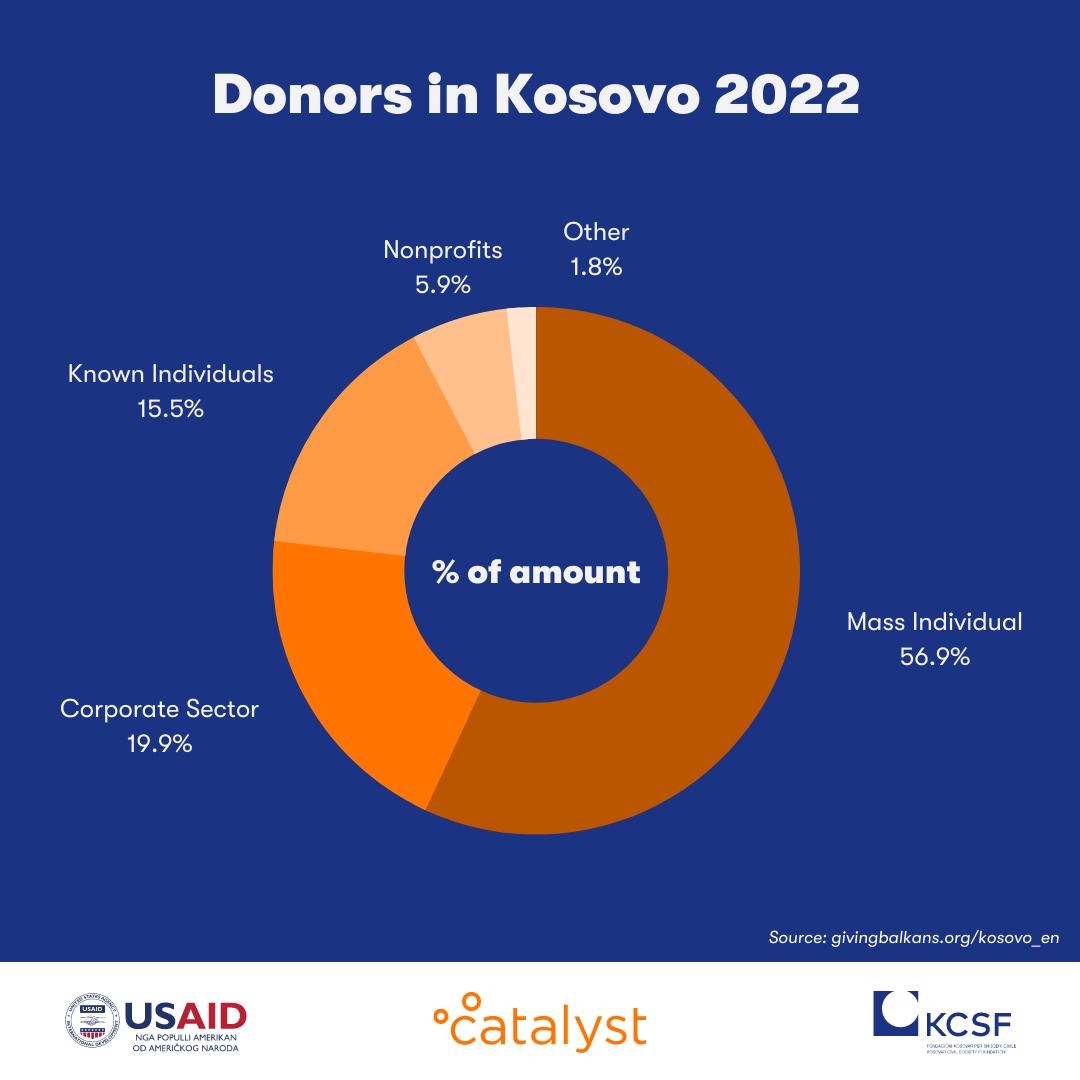
Donors in Kosovo in 2022 (% of the amount) - download the infographic in PDF
Mass Individual Giving
Mass individual giving accounted for 33.6% of all donation instances and 56.9% of the total recorded amount in 2022. The high share of recorded mass individual donation instances was correlated with the high number of campaigns in which citizens are the most frequent donors. Non-profit organizations represented the main distribution channel for mass Individual donations in 2022.

Donors in Kosovo in 2022 (% of instances) - download the infographic in PDF
Giving by Known Individuals
The second most active donor type in 2022 was known individuals, accounting for 29.7% of all donation instances and 15.5% of the total donated amount. Most frequently, giving from known individuals was provided directly to individuals and families in need or directed towards non-profit organizations.
Giving by Companies
Company and SME donors directed their support predominantly through domestic associations' work, mainly for poverty relief. Of all corporate donation instances, 60.8% were from companies, while 39.2% were from small and medium enterprises.
Trends in Types of Donors Giving in Kosovo – 2015-2022
Giving in Kosovo has been dominated by giving from individuals since tracking of philanthropy in Kosovo was initiated in 2015. Over time, giving by known individuals has slowly become a bigger portion of giving. Giving by companies and SMEs has also seen a general expansion in its share of overall giving.
To Whom Individuals Gave in 2022
Mass individual giving was primarily focused on giving through non-profit organizations (79.6%) and, to a lesser extent, directly to individuals or families (19.1%). Only 1.3% of mass individual donations recorded were directed to public institutions. Because dedicated fundraising campaigns largely drive mass individual giving, and because non-profits organize most fundraising appeals targeted to mass individuals, this distribution makes sense.
Giving by known individuals was broken down more evenly in 2022, with 49.5% directed to individuals and families and 43.2% given through nonprofit organizations. 4.4% was directed to the local or national government, and 2.2% to public institutions. Known individuals tend to follow their own theory of giving in addition to responding to appeals, so having a more equal distribution across recipient types is expected.

Individual Giving by Type of Recipient 2022 - download the infographic in PDF
For What Intended Effects Individuals Gave in 2022
More than 91% of all mass individual giving was directed to uses that aimed to achieve short-term impact, while just 4% was used in a way that would make a strategic difference. This contrasts with giving by known individuals, where nearly 33% of all donation instances could be classified as strategic giving, and almost 66% were directed to one-off impacts.
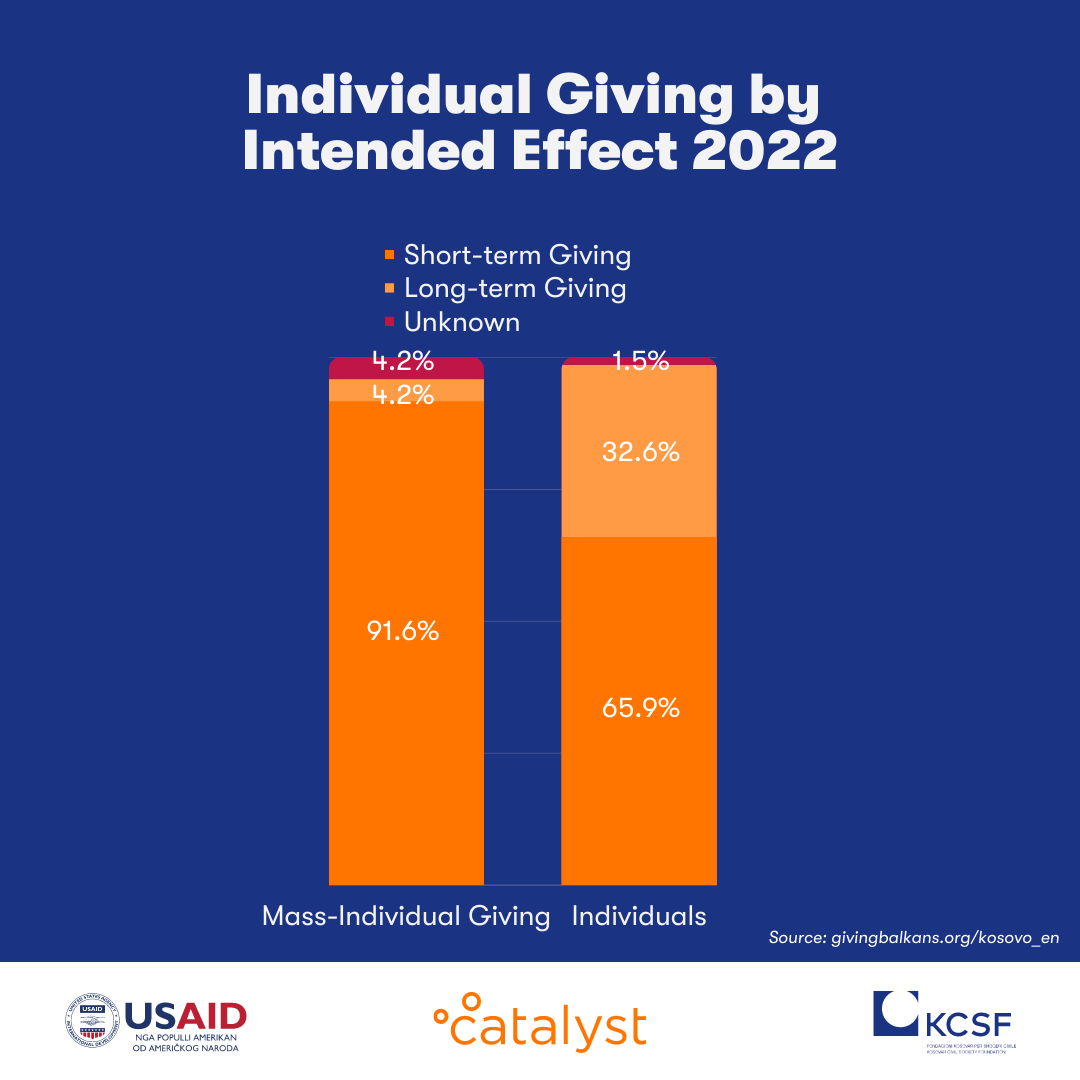
Individual Giving by Intended Effect in 2022 - download the infographic in PDF
To Whom the Corporate Sector Gave in 2022
Companies split their giving between non-profit organizations (46.2%) and individuals and families (43.5%). Less than 5% of corporate instances of donations were directed to public institutions or to the local and national governments.
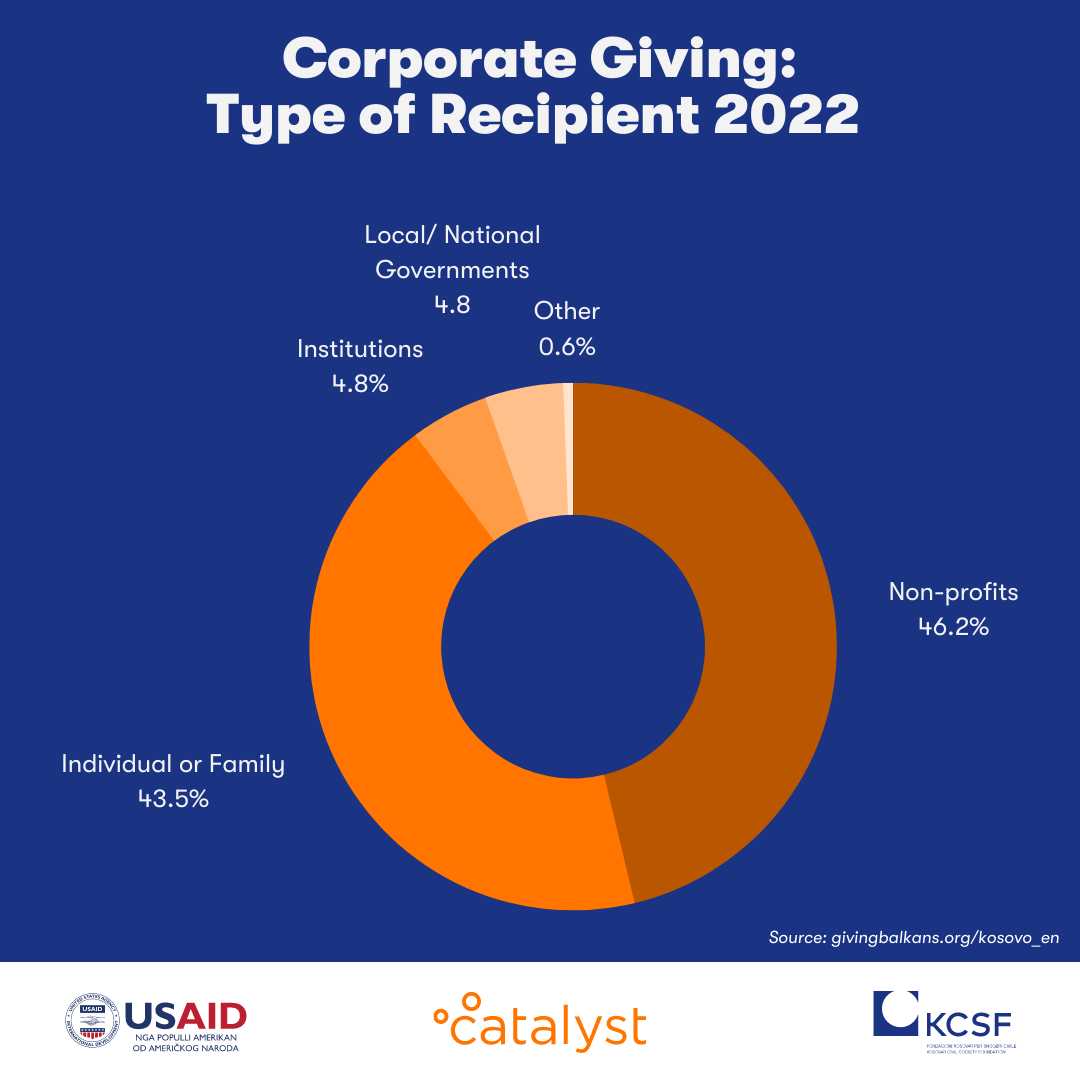
Corporate Giving: Type of Recipient in 2022 - download the infographic in PDF
For What Intended Effects Companies Gave in 2022
While in previous years, corporate giving was more directed towards achieving long-term strategic impacts because the overall focus of giving in 2022 was on poverty relief, the overwhelming majority (87.1%) of all instances of corporate giving were for the creation of short-term impacts. Just 7.5% of corporate giving was directed toward strategic outcomes in 2022.

Corporate Giving: Intended Effects of Giving in 2022 - download the infographic in PDF
To Whom the Diaspora Gave in 2022
The primary focus of giving from the diaspora was to give directly to individuals and families (53.6% of instances) in 2022, with giving to non-profits (41.1%) being a second strong giving pathway.
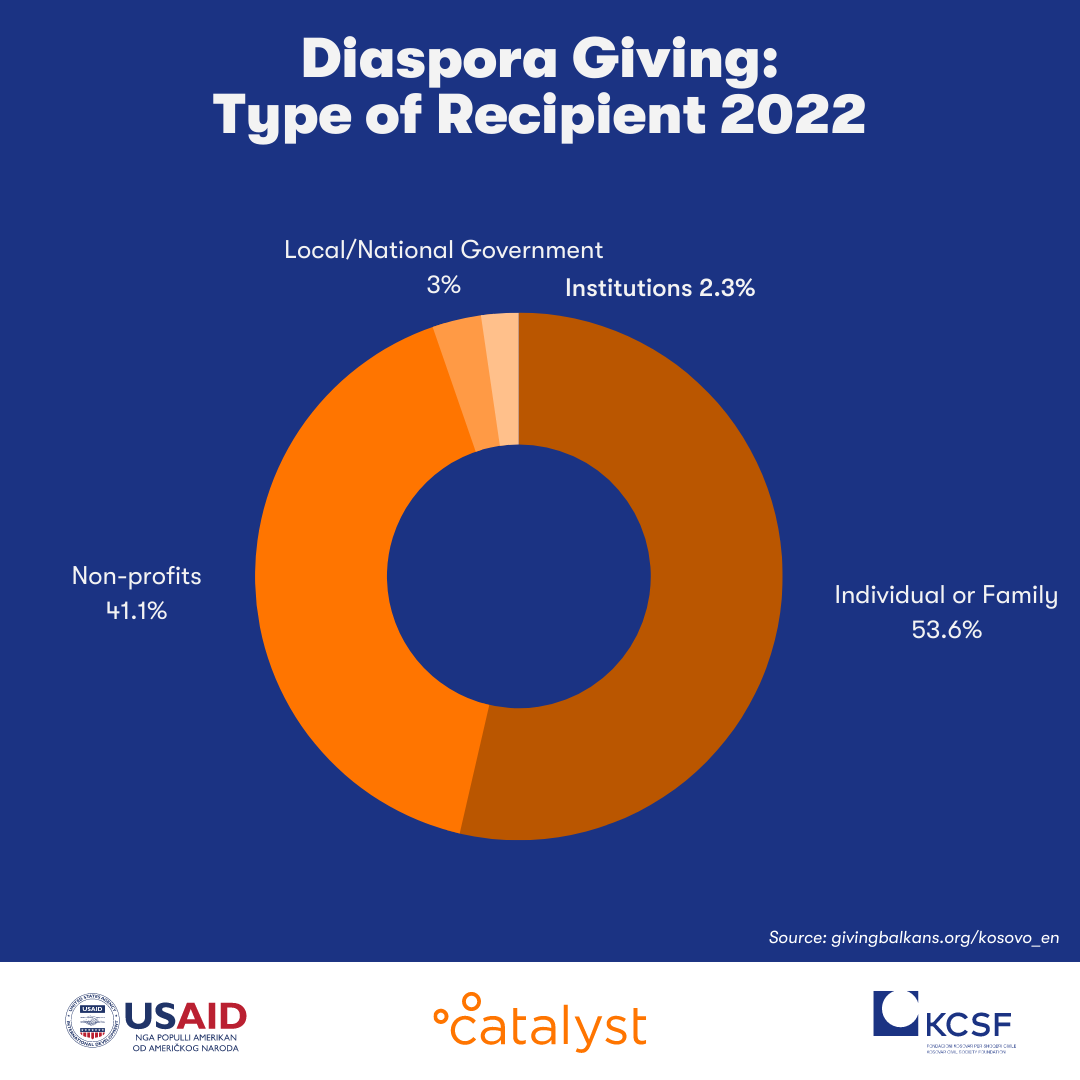
Diaspora Giving: Type of Recipient in 2022 - download the infographic in PDF
For What Intended Effects the Diaspora Gave in 2022
In contrast to other key donor types giving in 2022, giving for achieving strategic impact by the diaspora was more prevalent with 44.6% of all instances. The short-term impact was still the focus of more than 52% of all giving from the diaspora.
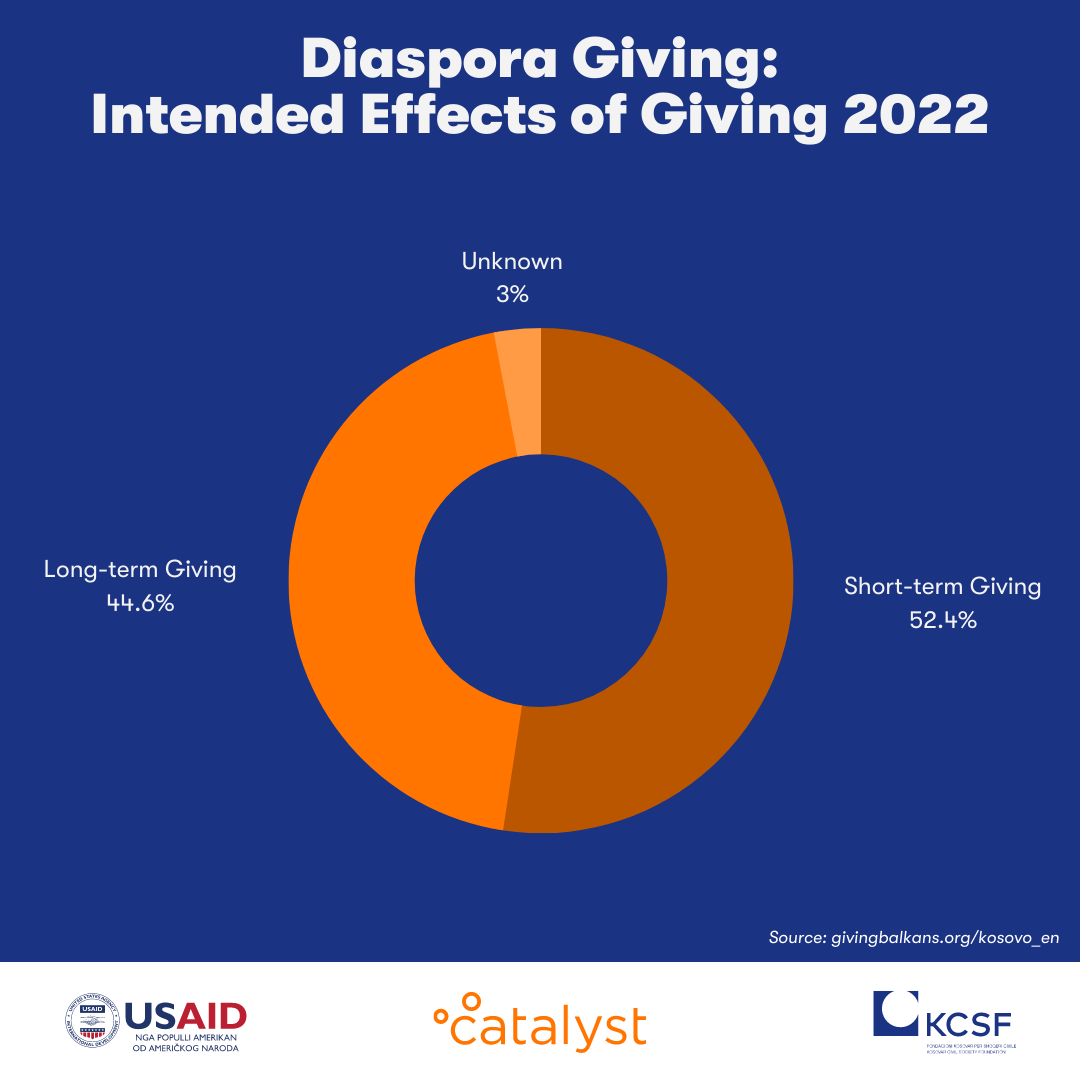
Diaspora Giving: Intended Effects of Giving 2022 - download the infographic in PDF
Examples of Giving
“Music 4 All”
Through the KOSOVA Ideas crowdfunding platform, citizens helped raise funds for the project initiated by Roma Versitas Kosovo to support the “Music 4 All” Music School in Plementina. The school offers free music classes and workshops for children and youth. The campaign lasted until 8 January 2022, and more than EUR 5,000 was raised, intended to purchase necessary teaching and art materials and equipment, funds for transportation, events, and heating bills.
Actions of the NLB Bank
NLB Bank donated didactic materials and equipment to the Speech Therapy Cabinet at the University Clinical Center of Kosovo (QKUK). The donated essential tools are intended for the treatment of children with communication and cognitive disorders. Additionally, the bank distributed gifts to several Kosovo associations that care for children with disabilities.
“1 Cent – Donate a little, help a lot!
An example of corporate support in 2022 was the campaign “1 cent – Dhuro pak, ndihmo shumë” (“1 Cent – Donate a little, help a lot!”). This action was organized by the company Fluidi Group through its newly established foundation Floil Cares. Using a cause-related marketing approach, one euro cent was donated from selling every bottle of Floil oil to support the Down’s Syndrome Kosova Association.
More on the state of philanthropy in Kosovo in 2022:
- Giving Kosovo 2022: Report on the State of Philanthropy
- Infographic: Who Gives the Most?
- Kosovo's Giving Trends in 2022: A Spotlight on Poverty Relief and Healthcare Donations
- Kosovo Philanthropy: Beneficiary Groups and Support Channels in 2022
- Shifts in Kosovo's Philanthropy: Recipient Trends and Giving Flows in 2022
- Understanding the Intended Effects of Philanthropic Giving in Kosovo: Short-Term vs. Long-Term in 2022
This report is made possible by the generous support of the American people through the United States Agency for International Development (USAID). The contents are the responsibility of Catalyst Balkans and do not necessarily reflect the views of USAID or the United States Government.
The Citizen Engagement Activity in Kosovo is a five-year initiative implemented by Kosovar Civil Society Foundation (KCSF) in partnership with the United States Agency for International Development (USAID).
Cover photo: unsplash.com


Leave a comment